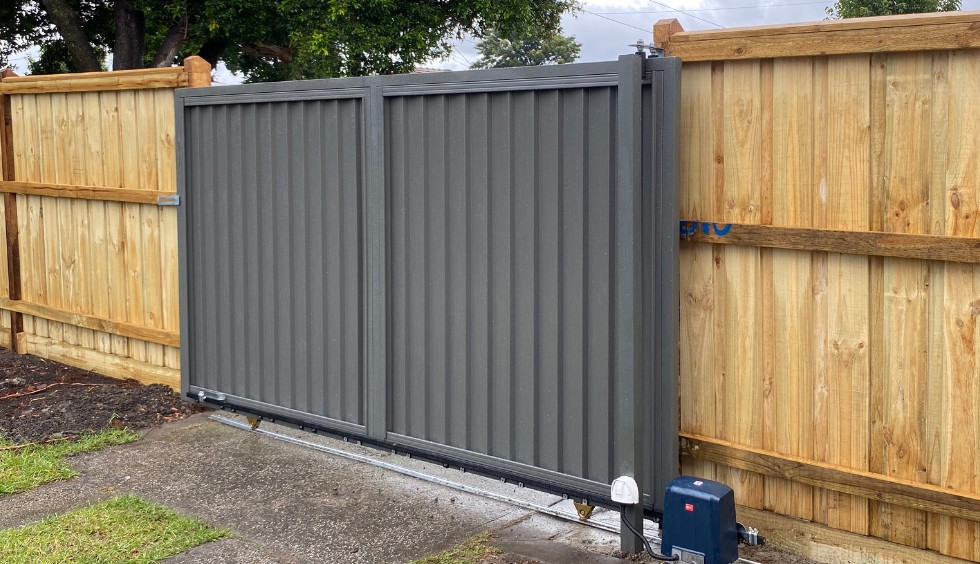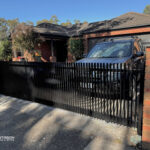In today’s world, gates are more than just barriers—they serve as the first line of defense for properties, offering security, privacy, and controlled access. Homeowners and business owners alike are increasingly looking at gates not just for functionality, but also for aesthetics and convenience. When it comes to choosing the right gate, two main categories emerge: manual gates and automated gates.
The purpose of this guide is to help you evaluate which option—manual or automated—is best suited for your specific property and needs. This decision will depend on factors like your property type, your security requirements, and your budget.
Understanding Your Needs
Before deciding between manual and automated gates, it’s crucial to understand the specific requirements of your property. Here are some key questions to consider:
What type of property do you have?
- Is it residential, commercial, or industrial? Different types of properties may have different security needs and budget considerations.
What is your primary goal?
- Do you prioritize security, privacy, or convenience? Understanding your main reason for installing a gate will influence your decision. For example, a family home may prioritize privacy, while a business might prioritize ease of access and security.
What is your budget?
- Your budget will play a huge role in determining whether a manual or automated gate is more feasible. While manual gates are generally more affordable upfront, automated gates can offer long-term benefits in terms of convenience and security.
What are Manual Gates?

Manual gates are a traditional option that requires physical effort to open and close. They are ideal for properties where simplicity, cost-effectiveness, and minimal maintenance are important. Here are some key aspects to consider:
1. Types of Manual Gates
- Swing gates: These gates open outward or inward and are one of the most common manual options.
- Sliding gates: These gates slide horizontally and are ideal for properties with limited space.
2. Pros of Manual Gates
Cost-Effective
One of the most significant advantages of manual gates is their lower upfront cost. Since they don’t require automation technology or electronic components, the cost to manufacture, install, and maintain these gates is typically much lower compared to their automated counterparts. For homeowners on a budget, a manual gate can be an excellent option.
Simplicity
Manual gates are simple to operate, with no complex parts, motors, or circuitry involved. This simplicity results in fewer potential points of failure, meaning you can expect a manual gate to last for years with minimal maintenance.
Durability
The design of manual gates is often robust, with materials such as steel, iron, and wood used for construction. Without motors or electronic components, manual gates tend to have a longer lifespan as they are not prone to technical malfunctions or power outages.
Less Maintenance
With fewer moving parts and no electrical components, manual gates require significantly less maintenance compared to automated gates. Cleaning, lubricating the hinges, and occasional painting or treatment for rust are the primary maintenance tasks for a manual gate.
3. Cons of Manual Gates
Inconvenience
One of the primary drawbacks of manual gates is the inconvenience of having to open and close the gate manually, especially in unfavorable weather conditions like rain, snow, or extreme heat. This can be particularly burdensome for elderly individuals or those with physical limitations.
Less Secure
Manual gates typically rely on a lock-and-key mechanism, which is not as secure as the automated locking systems found in automated gates. They can be vulnerable to tampering, and the act of manually locking the gate can sometimes be overlooked, leaving your property exposed.
Limited Customization
Manual gates generally offer fewer customization options when it comes to security features. For example, you won’t find motion sensors, cameras, or intercom systems integrated into most manual gate designs, which can limit their functionality in securing your property.
Weather impact
Manual gates can be more difficult to operate in bad weather, especially if you need to get in and out of your vehicle to open the gate.
4. Materials
- Wood: Popular for its natural look, but requires regular maintenance.
- Metal: More durable and secure, with materials like wrought iron, aluminium or steel offering long-lasting protection.
5. Additional Features
- Locks and latches: Many manual gates come with simple lock-and-latch mechanisms for security.
- Self-closing mechanisms: Some manual gates can include a self-closing feature, adding a layer of convenience.
What are Automated Gates?

Automated gates are powered by motors and controlled through remote systems or sensors. They offer a modern solution for properties that demand both convenience and enhanced security.
1. Types of Automated Gates
There are several types of automated gates, each suited for different property layouts and purposes:
- Swinging gates: Similar to manual swing gates, but automated with a motorized opening mechanism.
- Sliding gates: Automated sliding gates operate via motors and are excellent for properties with limited driveway space.
- Bi-folding gates: A space-saving option where the gate folds inwards when opening, typically used in urban settings.
- Cantilever Gates: These gates use a counterbalance system to open without the need for a ground track, making them ideal for uneven surfaces.
2. Pros of Automated Gates
Enhanced Security
Automated gates provide superior security compared to manual gates. Many models come equipped with electronic locks, motion detectors, surveillance cameras, and intercom systems. These features allow you to control who enters your property, even from remote locations. Additionally, the automation systems ensure the gate automatically locks after use, reducing the chance of human error.
Convenience
One of the key benefits of automated gates is their convenience. You can operate the gate without leaving your vehicle, which is especially helpful during bad weather or in the dark. Many gates also come with remote controls, keypads, or smartphone apps for added ease of use.
Integration with Smart Home Systems
Automated gates can be integrated with smart home systems, allowing for remote access control and monitoring. You can open or close the gate using a mobile device, and some systems even allow for voice commands using virtual assistants like Amazon Alexa or Google Assistant.
Higher Property Value
Installing an automated gate can increase your property’s value. Homebuyers often view automated gates as a sign of luxury and security, making properties with them more attractive.
3. Cons of Automated Gates
Higher Initial Cost
Automated gates are significantly more expensive than manual gates, both in terms of the initial purchase and installation costs. The complexity of the automation system, the inclusion of keypads, cameras, or intercoms, and the need for specialized labor all contribute to the higher price point.
Maintenance and Repairs
Unlike manual gates, automated gates require regular maintenance to ensure that the motors, sensors, and other electronic components remain functional. Breakdowns can be costly, particularly if the gate is out of warranty. Additionally, power outages can temporarily disable automated gates, which can be inconvenient unless there’s a manual override option.
Energy Consumption
Automated gates require electricity to operate, leading to higher energy bills. While this may not be a significant issue for some homeowners, it’s still a factor to consider, particularly if your gate has multiple features such as cameras and lights.
4. Opening Mechanisms
- Hydraulic systems: Known for their smooth and quiet operation, hydraulic systems are ideal for heavy gates.
- Chain drive: A more cost-effective option, but noisier and typically used for lighter gates.
- Screw drive: This system offers a balance between price and durability and is often chosen for residential properties.
5. Security Features
- Keypads: Allowing secure access with PIN codes.
- Intercom systems: Enable communication with visitors before granting access.
- CCTV integration: Many automated gates integrate with surveillance cameras, providing an additional layer of security for monitoring and recording activities.
Cost Considerations

xr:d:DAFeULKowEU:138,j:5969922246065189774,t:23082615
When deciding between manual and automated gates, it’s important to look at both upfront and long-term costs:
1. Upfront Costs
- Manual gates: Generally more affordable, with lower initial costs due to the lack of motors or electrical components.
- Automated gates: Typically more expensive upfront due to the cost of motors, sensors, and control systems. Installation can also be more complex and costly.
2. Maintenance Costs
- Manual gates: With fewer mechanical parts, maintenance costs are typically low. Occasional inspections for rust or wear on hinges may be necessary.
- Automated gates: Ongoing costs include electricity, periodic checks on motors, sensors, and wiring. Repairs to automation systems can be costly, particularly if parts need to be replaced.
3. Impact on Property Value
- Automated gates may add more to the resale value of a property, as they are seen as modern, secure, and convenient.
- Manual gates may not contribute as significantly to property value, though a well-maintained manual gate still enhances curb appeal.
Additional Considerations

Several other factors may influence your choice of gate:
1. Security Needs
- For properties that require heightened security, such as businesses or homes in areas with high crime rates, an automated gate with advanced security features like surveillance cameras and remote access is often the better option. A manual gate may not provide the same level of protection.
3. Convenience
- Consider how often you’ll be opening and closing the gate. If the gate is frequently used, an automated gate may be worth the extra cost for its convenience alone. If the gate is only used occasionally, a manual gate may suffice.
4. Property Size and Layout
- The size and layout of your property play a significant role in determining the best gate type. For example, sliding automated gates work well in properties with limited space, while manual swing gates require more room to operate. Automated gates can also be customized to fit various property layouts.
5. Maintenance Commitment
- If you prefer a gate that requires little to no maintenance, a manual gate may be the right choice. Conversely, if you don’t mind regular upkeep and occasional repairs, an automated gate offers more in terms of features and functionality.
6. Aesthetics: The design of the gate should complement the property’s architectural style. Both manual and automated gates offer a wide variety of materials and design options, from rustic wooden gates to sleek metal designs.
7. Local Regulations: Check for any local regulations or homeowner association (HOA) rules that may dictate the type of gate you can install.
8. Environmental Impact:
- Manual gates have a lower environmental impact due to their lack of reliance on electricity.
- Automated gates, especially those integrated with solar panels, can be an eco-friendly option.
9. Smart Home Integration: For those looking to integrate their gates with smart home systems, automated gates offer compatibility with apps and devices for seamless control and monitoring.
By considering all these aspects, you’ll be better equipped to choose the gate solution that meets your needs for security, convenience, and aesthetics.
Conclusion
Choosing between a manual gate and an automated gate depends on your specific needs, preferences, and budget. Manual gates are ideal for those who want a cost-effective and low-maintenance solution, while automated gates provide enhanced security, convenience, and the potential to increase your property’s value.
Ultimately, if security and convenience are your top priorities, investing in an automated gate may be worth the added expense. However, if you’re looking for a simple and budget-friendly option, a manual gate can still provide the protection and privacy you need for your property.




